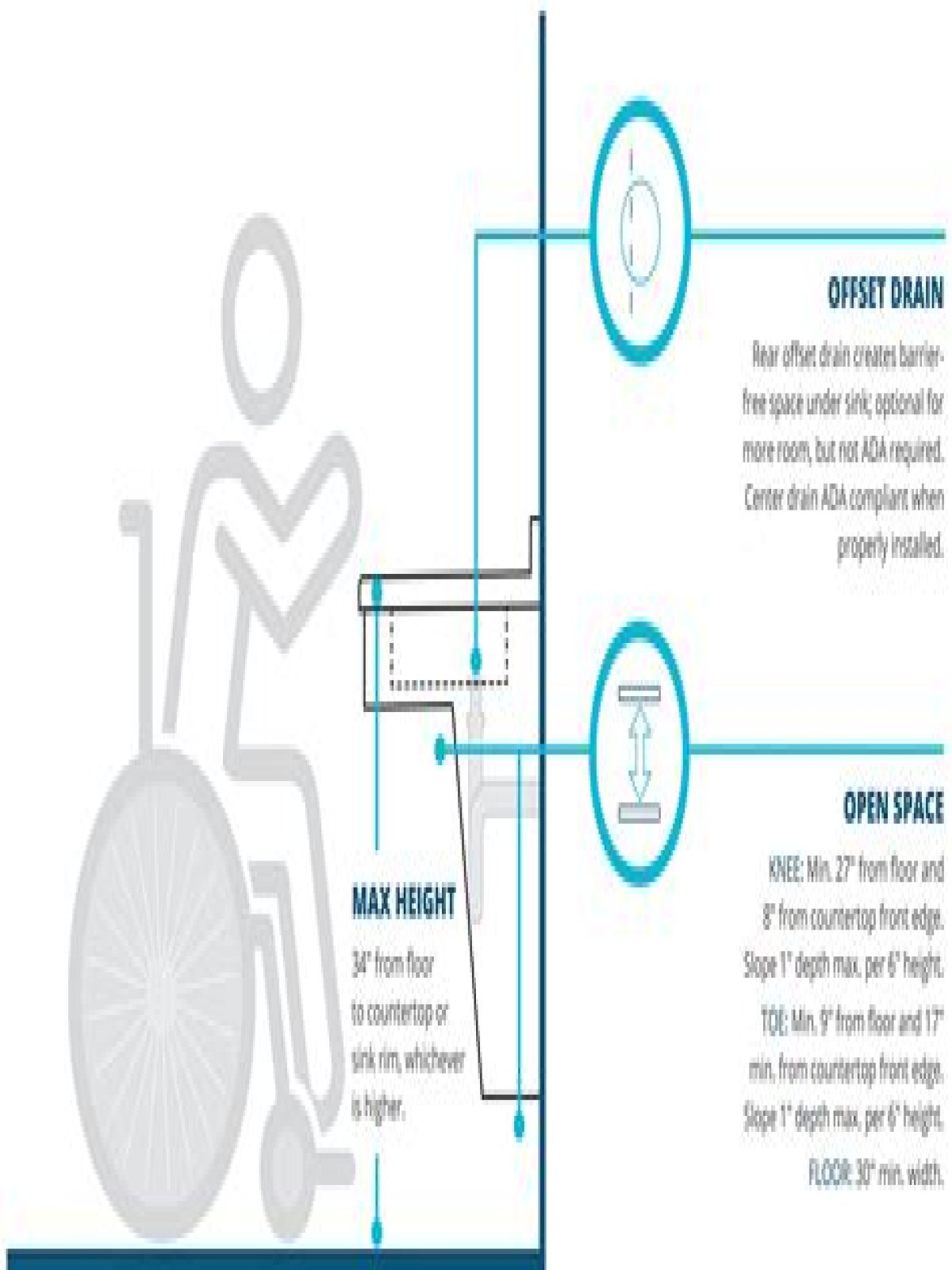How high does a handicap sink need to be?
34 inches Sinks & Faucets To meet ADA guidelines, sinks shouldn’t be mounted higher than 34 inches from the floor, and they should have a knee clearance of 27 inches high, 30 inches wide, and 11 to 25 inches deep. You also need a clear floor space and insulated pipes under the sink.
Do pedestal sinks meet ADA requirements?
ADA Compliant Pedestal Sink Height The bowl of the pedestal sink should be at least 27 inches from the ground level and not more than 34 inches high, according to the ADA requirements. The sink must be at least 6 1/2 inches deep.
What is an accessible sink?
A well accessible sink is one that is not too large, and one designed to leave some space underneath. Thankfully, this unit satisfies these requirements. The length is 18 inches and the height is 5 inches. Mounted on a wall, the sink leaves adequate space underneath for your knees to rest.
How much room is needed for a wheelchair clearance under a sink?
The ADA height requirement for sinks is no more than 34 inches from the floor with 27 inches for knee clearance. Sinks, or lavatories, also require minimum clearance area of 30 inches wide by 48 inches deep. This rectangular space reserves adequate room for wheelchair approach and maneuverability.
What is the minimum clearance for a wheelchair?
32 inches 1 Minimum Clear Width for Single Wheelchair. Figure 1. Minimum Clear Width for Single Wheelchair. The minimum clear width for single wheelchair passage shall be 32 inches (815 mm) at a point for a maximum length of 24 inches and 36 inches (915 mm) continuously.
Can a wheelchair turn radius overlap door swing?
Doors can swing into the turning space. The turning space can overlap other space requirements, including clear floor space required at elements and fixtures.
How do I make my shower wheelchair accessible?
How to Make Your Shower Handicapped Accessible
- Standard roll-in showers must be at least 30 in. wide by 60 in. deep, accessible from a front entry at least 60 in.
- The threshold height for roll-in showers must be no taller than ½ in.
- Grab bars must be installed horizontally no lower than 33 in. and no higher than 36 in.
What’s the shortest possible tailpiece on a drain basket?
You can use the shortest possible tailpiece on the drain basket and shortest possible section of pipe that is below where the disposal pipe comes in and slips into the trap. (There may be a trap that is not quite as deep as the one you have.) If that does not get you there then lowering the sanitary tee or shallower sink.
Do you need to lower the drain for a new kitchen sink?
Similar to many others, I’m installing a new sink that is significantly deeper than the one it is replacing. Due to added sink depth and the location the builder chose to install the original drain – I believe I need to lower the drain so that the waste can properly drain.
Why do I need to lower the garbage disposal drain?
Due to added sink depth and the location the builder chose to install the original drain – I believe I need to lower the drain so that the waste can properly drain. After the new counter top, undermount 10″ deep sink, and garbage disposal, I’ve determined that the garbage disposal drain will be about 1/2″ below the center of the waste drain.
Where is the garbage disposal in a sink?
After the new counter top, undermount 10″ deep sink, and garbage disposal, I’ve determined that the garbage disposal drain will be about 1/2″ below the center of the waste drain. I’ve determined that the drain is a dirty arm (horizontal style) drain instead of a more traditional trap drain (vertical style).
Is there a sink that is wheelchair accessible?
The sink’s back-wall conceals plumbing completely, which again is positive in relation to hygiene. Therefore, the product is suitable for a household of people with different needs. This product is both suitable for people with and without disabilities. Where Are Wheelchair Accessible Sinks Found?
What kind of material is used for a wheelchair sink?
Just as there are a variety of wheelchair sink designs, wheelchair sinks are made with a variety of materials that fulfill both functional and aesthetic purposes. Ceramics are the most frequently used material in sink construction, whether ADA-compliant or otherwise.
Which is better for a handicap bathroom sink?
Porcelain, like ceramic, is made from baked clay, but porcelain handicap sinks are harder and less porous than ceramic sinks. Especially in highly trafficked bathrooms, porcelain is desirable for its durability.
Can you use a garbage disposal with an ADA sink?
However, if you have a garbage disposal, measure ahead of time to make sure it will fit and be accessible if offset. Should someone in your household use a wheelchair, an ADA-approved sink will benefit them in many ways. Most ADA sinks have an offset drain, forcing the plumbing away from the front and allowing room for the chair to be tucked in.
